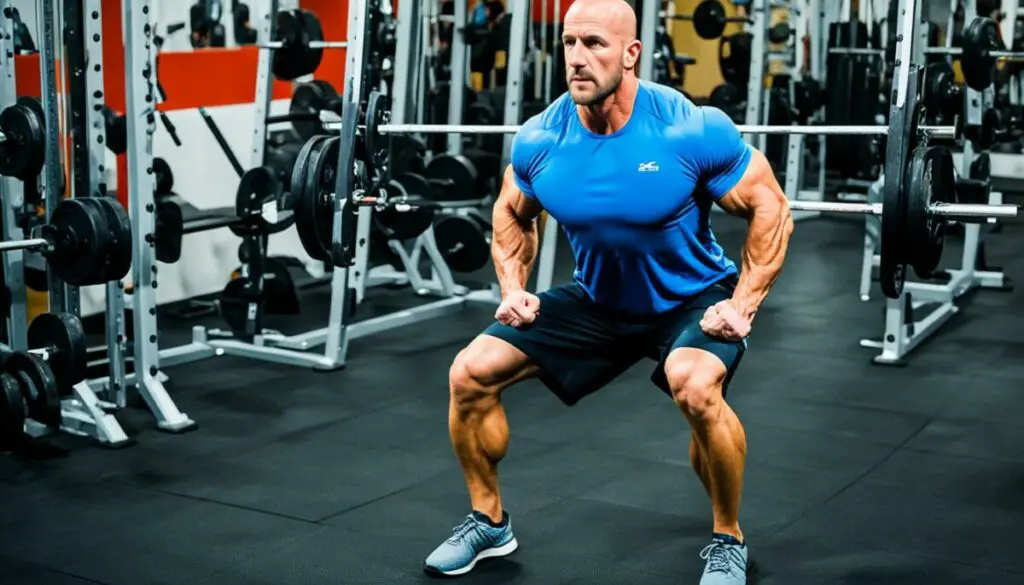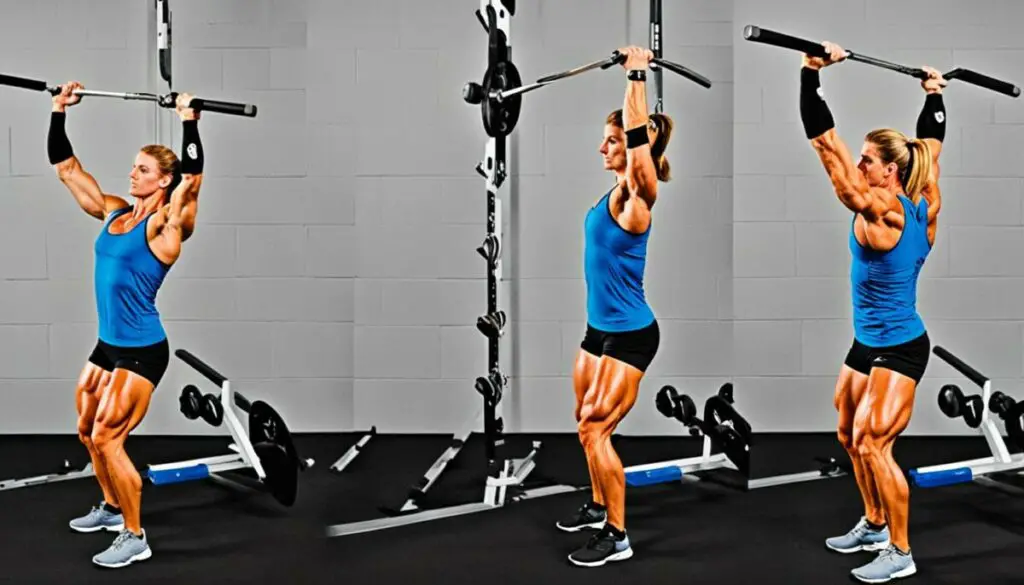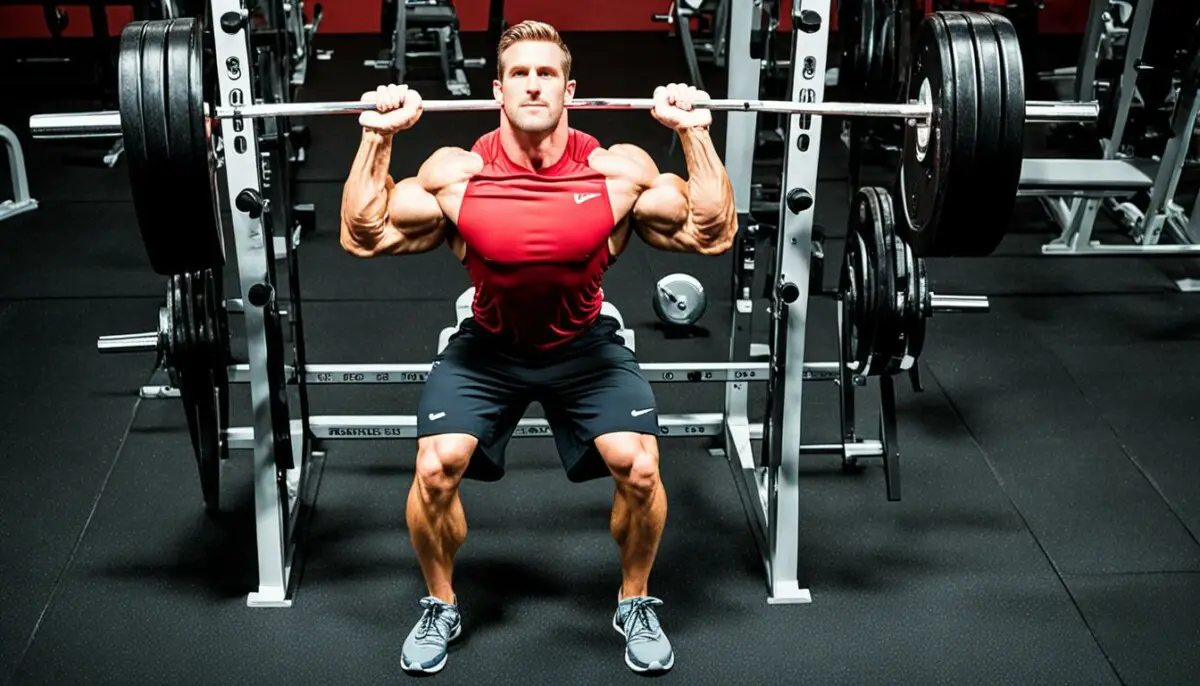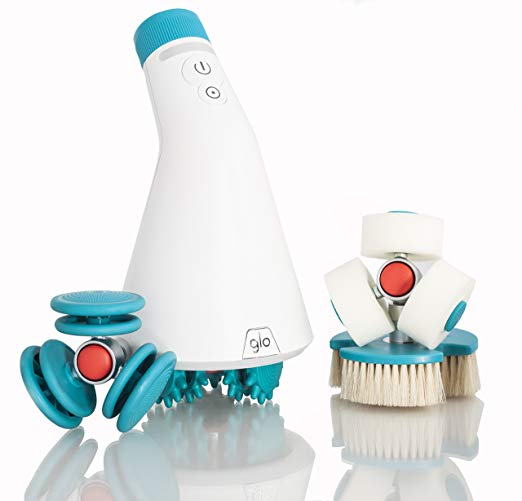Last Updated on 3 months by Francis
The Pendlay row is a highly effective exercise for targeting back strength and development, particularly for movements like snatches, cleans, and deadlifts. To reap the full benefits of this compound movement, it is crucial to achieve perfect Pendlay row form. This comprehensive guide will provide expert tips and techniques to help you enhance your lifting performance and maximize gains.
- Proper Pendlay row form is essential for optimizing back strength and muscle development.
- The Pendlay row is a variation of the bent-over barbell row that involves returning the weight to the floor after each rep.
- It targets various muscles in the back, arms, and core, providing a comprehensive workout for the entire posterior chain.
- By focusing on explosive strength and maintaining a flatter back, the Pendlay row offers several benefits for strength, muscle growth, and joint health.
- Programming the Pendlay row based on your goals and capabilities will help you effectively incorporate it into your training routine.
Contents
What is a Pendlay Row?

The Pendlay row, innovated by USA Weightlifting coach Glenn Pendlay, is a row variation that focuses on explosive strength from the floor. Unlike other row variations, the Pendlay row requires the weight to be returned to the floor every rep, eliminating momentum and forcing direct muscle engagement. It differs from the traditional bent-over barbell row by maintaining a flatter back and a more explosive lift.
Benefits of the Pendlay Row
The Pendlay row offers several benefits, including:
- Improved overall strength and muscle development.
- Enhanced explosive power and speed.
- Increased grip strength and forearm development.
- Improved back strength and posture.
- Engagement of multiple muscle groups, including the lats, trapezius, rhomboids, posterior deltoids, biceps, and spinal erectors.
By incorporating the Pendlay row into your training routine, you can achieve a more balanced and functional physique while enhancing your performance in other compound exercises.
How to Perform a Pendlay Row Correctly
- Stand with your feet shoulder-width apart, toes slightly turned out.
- Position the barbell on the floor, just above your shins.
- With a firm grip and a straight back, hinge at the hips and slightly bend your knees.
- Initiate the movement by explosively pulling the barbell towards your chest, focusing on squeezing your shoulder blades together.
- Lower the barbell back to the starting position under control, allowing it to touch the floor briefly before each repetition.
It is essential to maintain proper form throughout the exercise to maximize results and minimize the risk of injury.
Common Mistakes in Pendlay Row Form
“One common mistake to avoid is rounding the back during the movement. This can put unnecessary stress on the spine and diminish the effectiveness of the exercise. It’s important to keep the back flat and engage the core muscles for stability.”
Other common mistakes include using excessive hip or knee extension, using momentum to complete the lift, and neglecting a powerful arch of the middle back. By paying attention to these details, you can ensure proper form and maximize the benefits of the Pendlay row.
| Pendlay Row Form Mistakes | Correct Form |
|---|---|
| Rounding the back | Maintaining a flat back |
| Using excessive hip or knee extension | Focusing on explosiveness from the floor |
| Using momentum to complete the lift | Eliminating momentum and engaging direct muscle |
| Neglecting a powerful arch of the middle back | Emphasizing a strong back arch to engage all muscle groups |
Muscles Worked in a Pendlay Row

The Pendlay row is an effective compound exercise that targets multiple muscles in the back and arms. By performing this exercise with proper form, you can activate and strengthen the following muscle groups:
- Lats: The lats, or latissimus dorsi muscles, are the large muscles on the sides of your back. They are responsible for pulling movements and play a major role in the Pendlay row.
- Trapezius: The trapezius muscles run along the upper back and neck. They are involved in scapular retraction and provide stability during the rowing movement.
- Rhomboids: The rhomboid muscles are located in the upper back between the shoulder blades. They help retract the scapulae and assist in pulling the weight towards your body.
- Posterior Deltoids: The posterior deltoids, or rear delts, are the muscles at the back of the shoulders. They are activated during the pulling motion of the Pendlay row.
- Biceps: The biceps muscles are located in the front of the upper arm and assist in the pulling action of the row.
- Spinal Erectors: The spinal erectors are a group of muscles that run along the spine and provide support and stability throughout the rowing movement.
- Lower Back: The lower back muscles, including the erector spinae, are engaged to maintain a stable and neutral spine position during the exercise.
- Glutes: The gluteus muscles contribute to overall stability and help maintain a proper hip position throughout the row.
- Core Muscles: The core muscles, including the abs and obliques, engage to provide stability and prevent excessive movement during the row.
The Pendlay row targets these muscles by rowing the weight from the floor to the chest, engaging the entire range of motion and minimizing sticking points. By working these muscle groups, the Pendlay row can help build a strong and balanced back, enhance pulling strength, and improve overall athletic performance.
| Muscle Group | Primary Function |
|---|---|
| Lats | Major pullers during rowing movements |
| Trapezius | Scapular retraction and stability |
| Rhomboids | Scapular retraction and back stability |
| Posterior Deltoids | Assist in pulling motion and shoulder stability |
| Biceps | Assist in pulling the weight towards the body |
| Spinal Erectors | Support and stabilize the spine during the row |
| Lower Back | Stabilize the spine and maintain neutral position |
| Glutes | Provide stability and maintain proper hip position |
| Core Muscles | Stabilize the torso and prevent excessive movement |
Benefits of the Pendlay Row

The Pendlay row offers a wide range of benefits that can enhance your strength training and overall fitness. By incorporating this exercise into your routine, you can experience improvements in various aspects of your physical performance.
Here are some key benefits of the Pendlay row:
- Improved strength throughout the entire range of motion: Unlike other row variations, the Pendlay row requires you to return the weight to the floor after each rep, eliminating any cheating or momentum. This challenges your muscles more effectively and promotes strength gains across the full range of motion.
- Better flexibility and mobility: The Pendlay row involves a deep stretch in the starting position, which helps improve your flexibility and mobility in the shoulders, hips, and posterior chain.
- Increased power and muscle development: With its explosive nature, the Pendlay row is excellent for developing power and explosiveness in the upper and lower back, lats, and arms. It targets multiple muscle groups simultaneously, leading to increased muscle development and overall strength.
- Enhanced joint health: By performing the Pendlay row with proper form, you can strengthen the muscles around your joints and improve their stability. This can help prevent injuries and maintain good joint health in the long run.
Overall, incorporating the Pendlay row into your training routine can benefit individuals of all fitness levels and goals. Whether you’re looking to increase strength, build muscle, or enhance athletic performance, this exercise provides a challenging and effective option for achieving your desired results.
How to Perform a Pendlay Row Correctly

Performing a Pendlay row with correct form is essential to maximize its effectiveness and prevent injury. Follow these tips to ensure proper technique:
- Start with the barbell on the floor and set up with a wider than shoulder-width grip.
- Keep your hips slightly higher than the deadlift position and brace your core for stability.
- Engage your lats to explosively pull the barbell to the base of your chest.
- Avoid any shoulder elevation or hip movement during the lift.
- Drive your feet into the floor to generate power and focus on pulling the barbell toward your hips.
By following these guidelines, you can ensure proper execution of the Pendlay row and target the intended muscles effectively.
“Proper form is crucial for maximizing your Pendlay row results and minimizing the risk of injury. Engage your lats, avoid using momentum, and focus on the target muscles for optimal performance.”
The correct form ensures that you engage the targeted muscles and avoid compensatory movements that could diminish the exercise’s effectiveness. By mastering the Pendlay row technique, you can make significant progress in your strength and muscle development goals.
Tips for Perfecting Your Pendlay Row
Consider these additional tips to perfect your Pendlay row:
- Pay attention to your breathing pattern. Inhale during the eccentric (lowering) phase and exhale during the concentric (lifting) phase.
- Keep your back flat and avoid rounding it during the lift. This helps maintain proper spinal alignment and reduces the risk of injury.
- Focus on generating power from your lower body while maintaining upper body stability. This coordinated effort optimizes performance and muscle activation.
- Gradually increase the weight as your technique improves. Start with a weight that allows you to perform the exercise correctly without compromising form.
By implementing these tips, you can enhance your Pendlay row performance and make consistent progress towards your fitness goals.
Pendlay Row Variations

The Pendlay row offers several variations that can be incorporated into your training routine. These alternatives to the traditional Pendlay row provide unique challenges and benefits to help diversify your back workout and target specific muscle groups. Here are some popular Pendlay row variations:
- Pendlay Row Blocks: This variation involves using lifting blocks to elevate the barbell, reducing the range of motion. By starting from an elevated position, this variation targets the back muscles differently and places more emphasis on the middle and upper back. It also helps individuals who struggle with mobility or flexibility to perform the exercise with better form.
- Deficit Pendlay Rows: In this variation, you stand on plates or an elevated platform, increasing the range of motion. The extended range of motion allows for a deeper contraction of the back muscles, promoting greater strength and muscle development. It also helps improve body control and balance during the exercise.
- Seal Rows: Seal rows are a variation of the Pendlay row that focuses on mimicking the movement pattern and posture without putting strain on the lower back. Instead of bent-over positioning, this variation involves lying face down on an incline bench and rowing the barbell towards the lower chest. Seal rows provide an alternative for individuals with lower back issues or limited flexibility.
- Barbell Rows with a Narrow Grip: This variation involves using a narrow grip on the barbell, targeting the inner back muscles, such as the rhomboids and middle trapezius. By narrowing the grip, individuals can emphasize these muscles and develop a more defined back width. It can also provide a different stimulus and challenge the grip strength.
By incorporating these Pendlay row variations into your training routine, you can effectively target different muscle groups, enhance your strength and muscle development, and prevent plateaus. Remember to gradually introduce these variations into your workouts and focus on maintaining proper form and technique.
Who Should Do Pendlay Rows?
Pendlay rows can benefit a variety of lifters, including powerlifters, Strongmen/Strongwomen, and Olympic weightlifters. Let’s take a closer look at how each group can benefit from incorporating Pendlay rows into their training routines:
Powerlifters
Powerlifters can greatly enhance their performance in deadlifts by incorporating Pendlay rows into their training regimen. By focusing on hip and back strength, as well as lumbar stabilization, powerlifters can develop a stronger deadlift and a more solid foundation for their overall lifting abilities.
Olympic Weightlifters
Olympic weightlifters can also benefit from performing Pendlay rows. This exercise helps to develop upper and lower back strength, which is crucial for the pulls in weightlifting movements. By strengthening the back muscles used during clean and snatch variations, weightlifters can improve their stability and power output during these lifts.
General Population Lifters
Pendlay rows are not just for competitive lifters. General population lifters can also reap the benefits of this exercise. By incorporating Pendlay rows into their training routine, lifters can improve their posture, enhance their gym performance, and minimize the risk of injury. This exercise targets multiple muscle groups in the back and arms, making it a great addition to any strength and conditioning program.
Regardless of the lifter’s level or goals, Pendlay rows can be a valuable exercise for improving strength, muscle development, and overall performance. Its versatility and ability to target key muscle groups make it an effective choice for a wide range of individuals.
| Lifter Type | Main Benefits of Pendlay Rows |
|---|---|
| Powerlifters | Improved hip and back strength, enhanced lumbar stabilization |
| Olympic Weightlifters | Developed upper and lower back strength, similar to pulls in weightlifting movements |
| General Population Lifters | Improved posture, enhanced gym performance, minimized injury risk |
Common Mistakes in Pendlay Row Form

Mastering the Pendlay row form is essential for maximizing results and minimizing the risk of injury. However, many lifters make common form mistakes that can hinder their progress. By avoiding these errors, you can ensure a safe and effective Pendlay row workout. Let’s take a look at some of the most common mistakes:
- Not maintaining a flat back: One of the most crucial aspects of the Pendlay row is keeping your back flat throughout the movement. Avoid rounding your back or excessively arching it, as this can lead to strain and potential injuries.
- Using excessive hip or knee extension: The Pendlay row is primarily a back exercise, so it’s important to avoid relying too much on hip or knee extension to generate momentum. Instead, focus on engaging your back muscles and using them to initiate the movement.
- Jerking the weight with momentum: While it may be tempting to use momentum to lift heavier weights, jerking the weight can compromise your form and increase the risk of injury. Aim for a controlled and smooth movement throughout the exercise.
- Not focusing on a powerful arch of the middle back: To effectively engage your back muscles, it’s crucial to focus on creating a powerful arch in your middle back. This arch allows for a greater range of motion and helps target the intended muscle groups.
To achieve optimal results from your Pendlay row workout, it’s essential to maintain proper form and control. By avoiding these common mistakes, you can ensure that your training is effective, efficient, and safe.
“Proper form is the foundation of a successful Pendlay row. By correcting these common mistakes, you can maximize the benefits of this exercise.” – Coach Smith
Takeaway Tips:
- Focus on maintaining a flat back throughout the movement.
- Avoid relying too much on hip or knee extension for momentum.
- Control the weight and avoid jerking or using excessive momentum.
- Emphasize a powerful arch of the middle back to engage the target muscles.
How to Program Pendlay Rows for Strength & Hypertrophy

The programming for Pendlay rows can be tailored to specific goals. Here are some recommendations:
For Strength:
Perform three to five sets of four to eight reps with heavy weight. This intensity range will challenge your muscles and promote strength gains.
For Hypertrophy (Muscle Mass):
Opt for three to four sets of eight to 15 reps with moderate weight. This rep range and volume will stimulate muscle growth and size.
For Endurance:
Choose three to four sets of 15 to 20 reps with challenging but light weight. This higher rep range will enhance muscular endurance.
Remember to adjust the intensity, volume, and load based on your individual capabilities and progression. Listen to your body and gradually increase the challenge as you become stronger.
Sample Pendlay Row Programming:
| Goal | Sets | Reps | Weight |
|---|---|---|---|
| Strength | 4 | 6 | 80% 1RM |
| Hypertrophy | 3 | 12 | 70% 1RM |
| Endurance | 4 | 18 | 50% 1RM |
As you progress, you can modify the rep ranges, sets, and load to continuously challenge your muscles and ensure ongoing development. Remember to prioritize proper form and technique throughout your Pendlay row programming to maximize benefits and reduce the risk of injury.
Importance of Pendlay Row for Back Strength in Compound Lifts
The Pendlay row is an essential exercise for developing back strength and muscle hypertrophy, particularly for compound movements like deadlifts, squats, and weightlifting exercises. A strong back plays a crucial role in maintaining proper posture, stability, and power during these lifts, thereby reducing the risk of injury and enhancing overall performance.
When performing compound lifts, the back muscles must work synergistically with other muscle groups to generate force and movement. The Pendlay row specifically targets the back muscles, including the lats, trapezius, rhomboids, posterior deltoids, and spinal erectors. By focusing on these muscles, the Pendlay row helps build a solid foundation of back strength that translates into improved performance in compound lifts.
Developing back strength through the Pendlay row also promotes better spinal alignment and stability. Proper form and technique in the rowing movement help reinforce the natural curves of the spine, ensuring optimal load distribution and reducing the risk of strain or injury during heavy compound lifts.
In addition to strength and stability, the Pendlay row contributes to overall power production. The explosive nature of the movement, where the weight is returned to the floor between each rep, requires a strong and coordinated contraction of the back muscles. This translates into increased power generation during compound lifts, allowing for greater force output and improved performance.
Furthermore, the Pendlay row improves grip strength, another crucial aspect of compound lifts. A strong grip ensures secure control over the barbell or other equipment, facilitating proper execution and reducing the risk of accidents due to slipping or losing grip during heavy lifts.
To illustrate the importance of the Pendlay row for back strength in compound lifts, consider this comparison:
| Pendlay Row | Barbell Row |
|---|---|
| Targets back muscles more directly | Offers more time under tension |
| Emphasizes explosive movement from the floor | Allows for a slower and controlled movement |
| Maintains a flatter back position | Allows for a slightly more rounded back |
| Engages both upper and lower back muscles | Primarily targets upper back muscles |
While both the Pendlay row and barbell row have their benefits, the Pendlay row’s focus on explosive movement, direct back muscle engagement, and flat back position makes it particularly effective for developing back strength specifically for compound lifts. Incorporating the Pendlay row into your training routine can significantly enhance your performance and ensure a solid foundation of back strength for compound movements.
Pendlay Row vs. Barbell Row
The Pendlay row and barbell row are two popular exercises that target the back muscles and can be incorporated into a well-rounded training program. While they share similarities in movement patterns, there are distinct differences in technique and muscle recruitment.
The Pendlay row is a variation of the bent-over barbell row that puts a greater emphasis on explosive movement from the floor. It requires maintaining a flatter back throughout the lift, engaging both the upper and lower back muscles. This exercise is particularly effective for developing strength and power for movements like snatches, cleans, and deadlifts.
The barbell row, on the other hand, allows for more time under tension and can be a valuable exercise for muscle building. It involves pulling the barbell towards the chest while maintaining proper form and control. Although it may not provide the same explosive power and athletic carryover as the Pendlay row, it can still contribute to back strength and muscle hypertrophy.
“The Pendlay row emphasizes explosive movement from the floor, while the barbell row allows for more time under tension.”
Both the Pendlay row and barbell row offer unique benefits and can be effective additions to a comprehensive training routine. The choice between these exercises depends on individual goals, preferences, and specific training objectives. Incorporating variations of both exercises can help diversify back training and optimize overall performance.
Conclusion
Mastering the Pendlay row form is essential for maximizing back strength, muscle development, and overall lifting technique. By following proper form guidelines, incorporating variations, and programming the exercise appropriately, you can unlock the full potential of this compound movement and elevate your performance in various lifts. Perfecting your Pendlay row form requires consistent practice and attention to detail, but the results will undoubtedly be worth the effort.
When performing the Pendlay row, remember to maintain a flat back, avoid excessive hip or knee movement, and focus on generating power through your middle back. Implementing variations such as Pendlay row blocks, deficit Pendlay rows, seal rows, or barbell rows with a narrow grip can add versatility to your training routine and target specific muscle groups.
Whether you’re a powerlifter, weightlifter, or a fitness enthusiast, integrating Pendlay rows into your workouts can strengthen your back, improve posture, and minimize the risk of injury. With consistent practice and proper form, you can enhance your lifting performance, increase muscle development, and achieve your fitness goals more effectively.
FAQ
What is a Pendlay Row?
The Pendlay row is a variation of the bent-over barbell row that specifically targets back strength and development for pulling movements like snatches, cleans, and deadlifts. It requires the weight to be returned to the floor every rep, eliminating momentum and forcing direct muscle engagement.
Which muscles are worked in a Pendlay Row?
The Pendlay row targets various muscles in the back and arms, including the lats, trapezius, rhomboids, posterior deltoids, biceps, and spinal erectors. It also engages the lower back, glutes, and core muscles for stability.
What are the benefits of the Pendlay Row?
The Pendlay row offers several benefits, including improved strength throughout the entire range of motion, better flexibility and mobility, increased power and muscle development, and enhanced joint health. It is an effective back exercise for both strength and hypertrophy training.
How do I perform a Pendlay Row correctly?
To perform a Pendlay row with proper form, start with the barbell on the floor and set up with a wider than shoulder-width grip. Keep your hips slightly higher than deadlift position, brace your core, and explosively pull the barbell to the base of your chest while maintaining a flat back and avoiding shoulder elevation or hip movement. Drive your feet into the floor and focus on pulling the barbell toward your hips.
Are there variations of the Pendlay Row?
Yes, there are variations of the Pendlay row that can be added to your training toolbox. These include Pendlay row blocks, deficit Pendlay rows, seal rows, and barbell rows with a narrow grip.
Who should do Pendlay Rows?
Pendlay rows can benefit a variety of lifters, including powerlifters, Strongmen/Strongwomen, Olympic weightlifters, and general population lifters looking to improve posture and gym performance.
What are some common mistakes in Pendlay Row form?
Some common mistakes in Pendlay row form include not maintaining a flat back, using excessive hip or knee extension, jerking the weight with momentum, and not focusing on a powerful arch of the middle back. Maintaining proper form and control throughout the movement is important to avoid injury and maximize results.
How should I program Pendlay Rows for strength and hypertrophy?
The programming for Pendlay rows can vary based on specific goals. For strength, it is recommended to do three to five sets of four to eight reps with heavy weight. For muscle mass, three to four sets of eight to 15 reps with moderate weight are effective. Adjust the intensity and volume based on individual capabilities and progression.
What is the importance of the Pendlay Row for back strength in compound lifts?
The Pendlay row is an important exercise for developing back strength and muscle hypertrophy, which is essential for compound movements like deadlifts, squats, and weightlifting exercises. A strong back helps maintain proper posture, stability, and power during these lifts, reducing the risk of injury and enhancing overall performance.
How does the Pendlay Row differ from the Barbell Row?
The Pendlay row and barbell row have similar movement patterns but differ in technique and muscle recruitment. The Pendlay row emphasizes explosive movement from the floor, maintaining a flatter back, and engaging both upper and lower back muscles. The barbell row allows for more time under tension and can be effective for muscle building, but may not provide the same athletic carryover as the Pendlay row.









